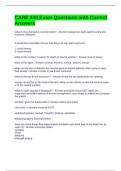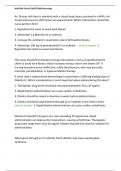CARE 443 Exam Questions with Correct
Answers
What is the emergency severity index? - Answer-Categorizes both patient acuity and
resource utilization.
5 levels that essentially tell you how long a pt can wait to get care
1- most serious
5- least serious
What is the number 1 reason for death of trauma victims? - Answer-loss of airway
parts of the spine - Answer-cervical, thoracic, lumbar, sacrum, coccyx
what can we use to stabilize the cervical spine in trauma patients when trying to open
their airway - Answer-c-collar or jaw thrust maneuver
What is the jaw-thrust maneuver? - Answer-thrust the jaw backwards not upwards
rescuer should be at the head of the bed, lifting on the cheeks so that the cervical spine
is in the neutral position
What is rapid sequence intubation? - Answer-procedure that is NOT rapid, but
organized controlled method of airway management- uses drugs to sedate and paralyze
the patient
atropine: given for bradycardia 3 minutes before procedure
Lidocaine: to prevent increase in ICP
sedative/Hypnotic: Versed, Propofol, fentanyl, etomidate
paralyzing agent: Succinylcholine
What are some things that might impede intubation and what type of pts might this be
seen in? - Answer-excessive saliva
vomiting
blood
dentures
enlarged tongue
,seizure pt
drowning victims
anaphylactic reactions
foreign body obstruction
cardiopulm arrest
intubation - Answer-Inserting an tube into the trachea for an artificial airway
tracheostomy - Answer-creation of an artificial opening into the trachea
Every critically ill person has a (increased/decreased) metabolic and oxygen demands
bc of the fight or flight response - Answer-increased
*When in doubt, give oxygen
Ventillation - Answer-movement of air into and out of the lungs
t/f
The heart is only mechanical - Answer-false
it is electrical and mechanical
if a pt is experiencing actual blood loss we may need to do a _____________
if a pt is experiencing a loss in blood volume we may need to add volume by doing a
________ - Answer-transfusion
IV bolus
a pts eyes can tell a lot about their head injury and/or nerve damage. Although, certain
drugs such as _____ can affect pupil response so it is important to ______ - Answer-epi
remember what drugs have been given and how this might affect the pt
A pt just came into the ED with a head injury. The pt is gazing with both eyes to the left
side. How might you interpret this? - Answer-The pt has a injury on the left side of the
head but potential deficits will be on the right side.
**If the pts is gazing to one side, that means the injury is on the side they are looking.
Although, deficits will be on the opposite side of the injury
***This will be important information to relay to the MD to help them gain a better
understanding of the pts injury
We want to make sure that our pt is cleaned before bringing them into the ED.
,If a pt has a powder substance on them, how do we clean this off?
If a pt has a liquid on them, how do we clean this off? - Answer-powder- brush off (do
not put water on it)
liquid- wash off
Why might we not want to use pain meds during primary survey? - Answer-pain meds
can cause vasodilation which can interfere with life saving interventions, VS, or LOC.
Therefore, we want to withhold typically until secondary assessment
What is the difference between a rapid response and full code - Answer-Rapid
response-
mobilizes a lot of help to PREVENT a code situation. It is a significant change in the pts
condition
Code- cardiac arrest or resp arret; no pulse, no respirs
. A 40-year-old male presents to triage with vague, midsternal chest discomfort,
occurring intermittently for one month. This morning, he reports a similar episode, which
has now resolved. Currently complains of mild nausea, but feels pretty good. Medical
history: Smoker. He is alert, with skin warm and dry, does not appear to be in any
distress.
ESI level? - Answer-ESI level II
This pt is high risk due to hx of angina for 1 month. These s/s are significant for a
potential cardiac ischemic event and acute MI is often accompanyed or preceded by
waxing and waning s/s. Must immediately get ECG
A 22-year-old female on college break presents to the triage desk complaining of
sudden onset of feeling very sick, severe sore throat, and feeling "feverish." She is
dyspneic and drooling at triage, and her skin is hot to touch.
ESI level? - Answer-Level II
high risk for epiglottitis which is a life threatening condition characterized by edema of
the vocal cords. Onset is rapid with a high temp, lethargy, anorexia, sore throat. High
risk for an airway obstruction and may need rapid access of an airway
. A 68-year-old male brought in by his wife for sudden onset of left arm weakness,
slurred speech, and difficulty walking. Symptoms began 2 hours prior to arrival. Past
medical history: Atrial fibrillation. Meds: Lanoxin. The patient is awake, oriented, mildly
, short of breath. Speech is slurred; right-sided facial droop is present. Left upper-
extremity weakness noted with 2/5 muscle strength.
ESI level? - Answer-level II
This patient is presenting with signs of an acute stroke and requires immediate
evaluation. If he meets criteria for thrombolytic therapy, he may still be in the time
window of less than three hours, but every minute counts with this patient. He is a very
high-priority ESI level-2 patient.
A 60-year-old male complains of sudden loss of vision in the left eye that morning.
Patient denies pain or discomfort. Past medical history: CAD, HTN. The patient is
slightly anxious but no distress.
ESI level? - Answer-High risk for central retinal artery occlusion caused by an embolus.
This is one of the few true ocular emergencies and can occur in patients with risk
factors of coronary artery disease, hypertension, or embolus. Without rapid intervention,
irreversible loss of vision can occur in 60 to 90 minutes.
A 22-year-old female with 10/10 abdominal pain for two days. Denies nausea, vomiting,
diarrhea, or urinary frequency. Her heart rate is 84 and she is eating ice cream.
ESI level? - Answer-level III
Since she is able to eat ice cream, you would not give your last open bed for this
patient. She will probably require at least two resources.
A 70-year-old female with her right arm in a cast is brought to triage by her daughter.
The daughter states that her mother fell yesterday and fractured her arm. The patient is
complaining of pain. Daughter states, "They put this cast on yesterday, but I think it's
too tight." Daughter reports her mother has been very restless at home and thinks her
mother is in pain. Patient has a history of Alzheimer's disease. The patient is confused
and mumbling (at baseline per daughter); face flushed. She is unable to provide verbal
description of her complaints. Her right upper extremity is in a short arm cast; digits
appear tense, swollen and ecchymotic. Nail beds are pale; capillary refill delayed.
Patient is not wearing a sling.
ESI level? - Answer-High risk level II
High risk for compartment syndrome. Despite the patient being a poor historian, the
triage nurse should be able to identify some of the signs of threatened compartment
syndrome: Pain, pallor, pulselessness, paresthesia, and paralysis. The patient requires
immediate life-saving intervention: Cutting of the cast and further evaluation for potential
compartment syndrome.
What is compartment syndrome? - Answer-Damage to nerves and vasculature of an
extremity due to compression






